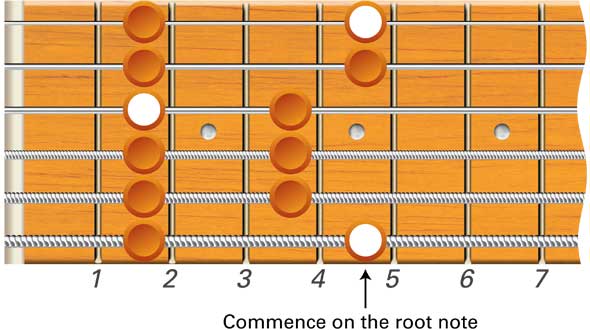
Using Pattern 1
In Pop, Rock and Country music there are three main types of chord progressions that songs are based upon, i.e. Blues progressions, minor key progressions and major key progressions. Pattern 1 can be used to improvise against all of these progressions but it is necessary to use it in the correct position on the fretboard.
Minor Pentatonic Scale
For improvising against most progressions, Pattern 1 commences on the same fret as the key note on the 6th string. When pattern 1 commences on the same fret as the key note it is called a minor pentatonic scale. The minor pentatonic scale can be used against Blues, minor key and major key progressions as shown in the following table.

For all three examples in the table above, if pattern 1 is played in the 5th position in the key of A, it is called the A minor pentatonic scale and the key note (often called the tonic, or the root note) is the first note (A). On the diagram, each octave of the key note is indicated by a white dot.
It is important to be able to visualize scale patterns and in particular the locations of the key note. This makes it easier to move the pattern up or down the fretboard to play in any key, as shown earlier in this lesson.
A Minor Pentatonic Scale
As the name suggests, this scale contains five different notes. Its degrees compared to a major scale are 1, b3, 4, 5, and b7. To learn more about scale degrees - see Progressive Scales and Modes by Peter Gelling.

Major Pentatonic Scale
When using Pattern 1 to improvise against a major key progression that contains major and minor chords, the pattern is played 3 frets below the key note. When pattern 1 commences 3 frets below the key note it is called a major pentatonic scale.

A Major Pentatonic Scale
Here is pattern 1 played as the A Major Pentatonic Scale in the second position. Its degrees compared to a major scale are 1, 2, 3, 5, and 6. To learn more about scale degrees - see Progressive Scales and Modes for Guitar by Peter Gelling.

You will notice that this pattern is identical in shape to the minor pentatonic scale, but it contains different notes and is played three frets lower. The root note (A) is shown as a white dot.
Examples of Blues, minor key and major key progressions can be found in the Jamming Progressions Section. These progressions are in various keys, so be careful to use pattern 1 in the correct position, as is shown in the previous chart.
The notes in the pattern can be played in any order or timing against any chord in the progression and will sound correct. Play the Pattern 1 licks from earlier in this lesson against these progressions. Try to make up your own licks. In the following lessons you will learn lead guitar techniques that will give you more ideas on how to use the notes in improvising pattern 1.
- For more information on Blues progressions, see 12 Bar Blues Progressions .
- For more information on minor key progressions, see Minor Key Progressions .
- For more information on major key progressions, see Major Key Progressions .